AI publishing methods are no more a advanced principle but a practical option reshaping the way in which content is created. By leveraging artificial intelligence, these tools have become needed for experts seeking to improve their workflows, elevate material quality, and undertake the growing requirements of the electronic material landscape. Content Writing (เขียนเนื้อหา) tools are transforming material development with crucial data and insights.

Improved Efficiency and Pace
One of the most substantial benefits of AI writing methods is their ability to dramatically minimize the time allocated to making content. According to recent information, AI content technology resources can increase the writing process by as much as 50%, allowing authors to make supreme quality function in a fraction of that time period it'd typically take.
These methods achieve this by automating similar responsibilities like grammar checks, rephrasing, and even generating whole drafts centered on insight prompts. For instance, marketers is now able to produce outlines, social media posts, or e-mail campaigns in a subject of moments, freeing up useful time to target on technique and creativity.
Increased Content Quality and Reliability
Data show that 65% of material marketers battle with maintaining consistent quality across their output. AI publishing instruments resolve this dilemma by giving functions such as grammar modifications, tone changes, and readability enhancements. These resources make certain that the last material is refined, qualified, and aligned with the intended audience's needs.
Still another crucial feature is the capacity to maintain brand voice continually across several types of copy. Whether it's a conventional post or a fun social media update, AI instruments can conform and refine the tone to resonate with readers.
Increased SEO Performance
Making content enhanced for research engines is really a difficult however vital task. Study suggests that 68% of online experiences start with a search engine, making SEO an fundamental element of material creation. AI-powered instruments can produce keyword-rich material and recommend changes to meta titles, explanations, and headers, supporting authors develop SEO-friendly articles that rank higher on search results.
Some tools also analyze previous developments and recommend content issues that will probably entice higher traffic. By establishing keyword study and optimization in to the writing process, firms may assure their material reaches a broader audience.
Personalization and Audience Wedding
AI resources use equipment understanding formulas to analyze market information and provide actionable insights. These methods allow the formation of individualized material that resonates with specific demographics. Data demonstrate that customized content pushes 80% higher proposal charges, demonstrating their performance in catching and preserving reader attention.
As an example, AI may recommend terms or matters centered on individual behavior, ensuring that material is applicable and participating for the goal audience. That level of personalization enhances person experience and fosters stronger contacts with readers.
The Future of AI in Material Development

The affect of AI in material generation is undeniable, but this is just the beginning. Business forecasts claim that the market for AI content technology methods may grow by 20% annually around the following five years. As the technology evolves, these tools are expected to become a lot more advanced, giving characteristics such as for instance multilingual functions, real-time market feedback, and greater creative collaboration.
AI publishing resources aren't here to replace human writers but to empower them. By automating schedule projects, ensuring quality, and offering data-driven insights, these methods are reshaping digital transmission and allowing designers to create more impactful and successful content. The rise of AI in this subject signals a thrilling era of creativity in content creation.
